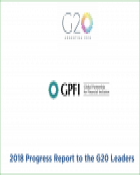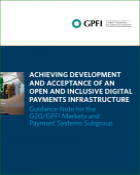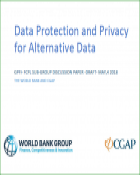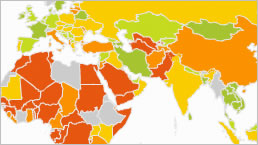| Aug 5, 2020
Digital financial services have expanded opportunities for millions of women across the globe. More than 240 million more women now have an account with a financial institution or mobile money service, compared to 2014. Through this increased engagement in the formal economy, women’s resilience to financial, economic and health shocks is improving. However, there remains much work to do to achieve gender equality in financial services. Approximately one billion women do not have formal financial services, due to persistent barriers in access to identification documents, mobile phones, digital skills, financial capability, as well as inappropriate products and more. Endorsed by G20 finance ministers, the report outlines 10 policy options to enable G20 members and other governments to
Report | Jan 16, 2020
The GPFI under the Saudi Presidency will focus its work on harnessing digital and innovative technologies to boost the financial wellbeing of youth, women and SMEs. The main GPFI priorities in 2020 will be (1) Formulating high-level policy guidelines on digital financial Inclusion for youth, women and SMEs and supporting reports. (2) Finalizing the Streamlining “GPFI Work Program and Structure: A Road Map to 2020.” (3) Reviewing and updating the Financial Inclusion Action Plan.
| Apr 16, 2020
Remittances represent a major source of income for millions of families globally and often a critical first point of entry into the regulated financial market for conventionally unbanked segments of the population. For many families and persons worldwide, their remittance receiving account increases visibility, thus accessibility, of other financial services and encourages people to conduct transactions via more transparent means that are subject to at least some AML/CFT monitoring.G20 countries will continue to work on cost reduction objectives and other policy goals, while remaining alert to the challenges posed by indiscriminate ‘de-risking’ actions as well as the opportunities offered by economies of scale and innovation in the financial technology space. On the one hand, ‘de-risking’
Report | Aug 9, 2019
Remittances represent a major source of income for millions of families globally and often a critical first point of entry into the regulated financial market for conventionally unbanked segments of the population. For many families and persons worldwide, their remittance receiving account increases visibility, thus accessibility, of other financial services and encourages people to conduct transactions via more transparent means that are subject to at least some AML/CFT monitoring.G20 countries will continue to work on cost reduction objectives and other policy goals, while remaining alert to the challenges posed by indiscriminate ‘de-risking’ actions as well as the opportunities offered by economies of scale and innovation in the financial technology space. On the one hand, ‘de-risking’
Report | Jun 6, 2019
Aging is a global phenomenon. The number, and the proportion as a share of the population, of older people are both growing rapidly in many developed and developing countries. Other countries will experience such growth in years to come. The United Nations predicts that, by 2050, there will be over two billion people aged 60 and above worldwide. One in five people in developing countries will be 60 or more. While definitions and concepts of what constitutes “old” differ around the world, such significant demographic shifts create new challenges for policymakers seeking to achieve sustainable financial inclusion. It is important to address these now, rather than placing unnecessary financial burdens on younger generations or add to inequality.In particular through the Global Partnership
Report | Feb 22, 2019
Japan’s GPFI 2019 Priorities Paper highlights aging and financial inclusion. This is in line with GPFI's contribution to the overall G20 Finance Track and working on the 2017 Financial Inclusion Action Plan (FIAP) towards 2020, which identifies "the elderly" as one of the vulnerable groups for financial inclusion.
Report | Dec 6, 2018
The 2018 Buenos Aires Action Plan (the Action Plan) sets out the G20's collective strategy for achieving strong, sustainable, balanced and inclusive growth.
Report | Dec 6, 2018
Argentina led the G20 under the theme "Building consensus for fair and sustainable development". In particular, for the GPFI Argentina focused on the interaction between digitisation and informality. In that regard, Argentina produced the "G20 Policy Guide on Digitisation and Informality: Harnessing digital financial inclusion for individuals and MSMEs in the informal economy" and continued with the ongoing work from the GPFI Subgroups towards the 2017 FIAP implementation.This priority, plus action areas, cross-cutting issues, and overarching objectives outlined in the 2017 GPFI FIAP, have guided the work of the GPFI in 2018. Special attention was paid to the financial inclusion of underserved groups, notably women, forcibly displaced persons, and those in the informal economy.
Report | Aug 3, 2018
Developed for financial inclusion policymakers and payment service regulators, this note proposes policy options and practical actions that can help moving toward developing open and inclusive digital payment infrastructures, while also incentivizing the acceptance and use of digital payments.
Report | Jul 26, 2018
The objective of this paper is to provide guidance for countries to use in considering key options to mitigate risks associated with data protection and privacy, especially related to alternative data, but not to direct adoption of unduly prescriptive legislative provisions.






